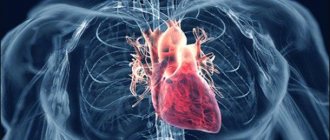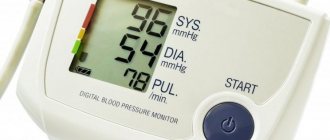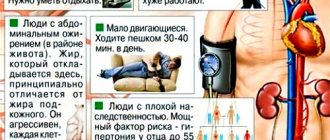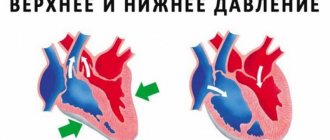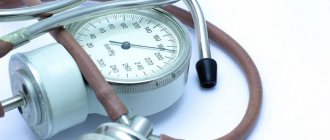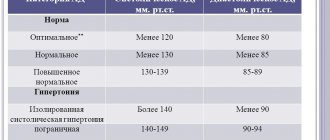Despite the fact that hypotension in children is less dangerous than high blood pressure, it still causes discomfort to the child and is harmful to his health.
It is very important to notice this pathology in time and consult a doctor who, after conducting an appropriate examination, will be able to recommend the best way to increase blood pressure.
Meaning of indicators
The human heart is a pulsating pump, the main function of which is alternating periods of contraction and relaxation.
Systolic (upper value) is the pressure in the vessels carrying blood from the heart to the organs during the period when the fibromuscular organ (heart) contracts and pushes out blood. During the contraction phase (systole), blood is ejected from the left and right ventricles and pumped into the systemic and pulmonary circulations, respectively.
Diastolic (lower value) - pressure reflects the resistance of peripheral blood vessels. During the relaxation phase (diastole), the ventricles fill with blood in preparation for the next phase of contraction.
Blood pressure standards for teenagers
Before you understand why a teenager has low blood pressure, you need to understand what indicators are normal for this age group.
Various factors such as gender and age have a great influence on blood pressure. In children, the range of indicators is lower than in adults. The optimal pressure for all age groups over seventeen years is 120/80 mm Hg. Art. To avoid confusion with formulas, average data for adolescents were introduced.
For children 10-12 years old, systolic pressure readings in the range of 110-126 mmHg are considered normal. Art., diastolic – 70-82 mm Hg. Art. At the age of 13-15 years, the norm for upper pressure is 110-136, lower – 70-86. In adolescents 15-17 years old, systolic and diastolic pressure levels are 115-140 - 75-95 mm Hg. Art. respectively.
Such standards depend on certain indicators:
- elasticity, from the lumen of blood vessels, the development of the capillary web;
- low blood pressure in a 14-15 year old teenager can be traced during puberty, when the formation of the vascular system lags behind the needs of the body;
- stress associated with the active formation of the psyche (worldview).
Diagnostics
Problems with blood pressure can worsen a child’s quality of life and disrupt the functioning of body systems. Therefore, in case of such problems, you should visit a doctor for a detailed diagnosis.
First of all, blood pressure is measured during the examination. The patient must sit. The procedure is carried out in the morning.
Blood pressure readings are checked at least three times with a break of several minutes. If each time the results are lower, then additional examination is necessary.
If hypotension is suspected in children, then prescribe:
- Electrocardiogram.
- Ultrasonography.
- Clinoorstatic test. The doctor assesses the condition of the heart and blood vessels when the child suddenly changes body position.
- Bicycle ergometry. A test that shows how the body reacts to physical activity.
- Rheoencephalography.
- Electroencephalography.
- Checking the condition of the fundus.
- Study of the nervous system.
- Consultation with a psychologist.
Therapy is prescribed depending on the examination results.
Symptoms of low blood pressure
The healthcare system is designed so that the child must undergo medical examination once a year. The rest of the time, guardians must monitor the health of their children themselves. Low blood pressure in a teenager can be recognized by certain signs. They will be fundamental for contacting a specialist:
- Frequent and rapid fatigue.
- Tired look.
- Distraction of attention.
- Dizziness.
- Blurred vision.
- Strong or irregular heartbeat.
- Increased thirst.
- Pale skin.
- Dyspnea.
- Decreased body temperature.
Insufficient oxygenation of the brain due to low blood pressure leads to a feeling of uncertainty in spatial orientation, exhaustion, and the teenager cannot concentrate. When changing body position, balance is lost, accompanied by attacks of dizziness up to fainting. In medicine, this condition is called orthostatic hypotension.
Factors influencing blood pressure reduction in adolescents
Hypotension in children is a dangerous condition. The causes of low blood pressure in teenagers can be different. They can be reversible, such as dehydration, or they can be dangerous, such as anemia.
The main reasons include:
- Poorly balanced diet (lack of vitamins, protein foods, iron-containing foods).
- Lack of daily routine, lack of sleep.
- Stressful situations.
- Dehydration – a teenager consumes much less fluid than necessary.
- Medicines that affect the tone of blood vessels.
- Adrenal insufficiency, in which there is a lack of mineralocorticoids.
- Anemia is an abnormally low concentration of red blood cells.
- Bacterial infection.
A 15-year-old teenager may have low blood pressure due to hormonal changes. The male hormone testosterone has a powerful effect on the human body and brain. As soon as a young man reaches puberty, the body begins to produce levels of this substance. The increased work of the pituitary gland and the release of hormones into the blood place a strong burden on the body. Under the influence of androgen, the characteristic features of adult men are formed. It is difficult and long for teenage boys to get used to such changes.
All these reasons relate to functional disorders. There are also organic factors that cause a teenager to have low blood pressure. They are associated with serious health problems, and they try to identify them as early as possible:
- Disorders of the pituitary gland and thyroid gland (diabetes mellitus)
- Pathologies of the circulatory system: thrombophlebitis, varicose veins, heart disease.
- Gastrointestinal diseases.
Such disorders pose a dangerous threat to young people; their diagnosis and treatment must be carried out under the strict supervision of doctors.
Therapy
Establishing the causes of low heart pressure will allow us to correctly combat their elimination.
Drug therapy
In case of pathology, treatment is prescribed using special medications:
- Adaptogens. Biologically active preparations based on herbal ingredients. They differ in their strengthening and general stimulating effect.
- Nootropics. They influence the course of higher mental options of the brain. They stimulate intellectual potential, encourage studying educational material, and improve the ability to concentrate.
- Antidepressants. Psychotropic medications that reduce the degree of internal tension, improve morale and regulate brain functions.
- Tranquilizers. Means that are intended to reduce nervous excitement, anxiety, and phobias.
Other measures are also used to raise the teenager’s blood pressure.
Daily regime
It is valuable to alternate school activities with relaxation. Excessive loads when studying and preparing lessons at home lead to depression.
To reduce daily stress, you should:
- attend sports sections and interest groups;
- spend more time in the fresh air;
- moderate mental activity.
Before going to bed, it’s time to read a book or look at a magazine, and don’t sit on your smartphone or laptop until late.
Exercise stress
To help a teenager cope with hypotension, the day needs to start with exercise. Oxygen is necessary for full supply to the organs. Without physical training, the growing body is characterized by weakness and lack of initiative. Both passivity and overexertion are harmful to health. Physical education classes (without fanaticism) are an accessible way to increase blood pressure for a teenager. Physical activity in the open air after school hours stabilizes blood pressure.
Diet
Prohibited foods:
- fast food;
- salted and smoked dishes;
- soda, packaged juices;
- fatty and fried foods;
- baked goods and sweets;
- mayonnaise and ketchup.
A balanced diet for hypotension contains: seasonal vegetables and fruits, poultry, lean meat, and cereals. To maintain fluid equilibrium, sufficient amounts of water are consumed.
Prevention of hypotension
Having found out the reasons why a teenager has low blood pressure, it’s easier to figure out what to do. If various diseases become the factors causing the pathology, then drug therapy is prescribed. In all other cases, blood pressure is normalized with the help of a healthy diet, reduced stress, and physiotherapeutic procedures.
If a child has psychological problems, you need to talk to him and try to win him over. At the age of 15-17 years, children graduate from school and take their first serious independent step. Many high school students are not mentally ready for such changes. Low blood pressure in a 16-year-old teenager may be associated with stress experienced as a result of these events.
Symptoms
Hypotension in adolescents and children is most often accompanied by the first signs and symptoms. Most often this is:
- headache and dizziness;
- rapid fatigue and constant desire to sleep;
- loss of interest in everything new;
- tearfulness;
- skin that is paler than usual;
- disturbance of night sleep;
- always cold extremities;
- state of suffocation in a closed room.
If at least a few of the symptoms listed are observed, the child should measure his blood pressure and, if necessary, consult a doctor.
In more severe cases, a hypotonic crisis may develop when the pressure decreases. In this case, the child may experience nosebleeds, confusion, and even fainting.
Constantly low blood pressure has a bad effect on the child’s immunity, and, as a result, frequent colds begin.
Parents may also be interested in the fact that hypertension can progress to hypotension. Therefore, constant monitoring of a child’s blood pressure is mandatory.
Treatment methods: proper nutrition
Young people love fast food and frozen instant foods. Boys and girls do not know how and do not like to cook. They often order pizza, go to McDonald's or other places that offer fast food. Such nutrition must be, if not excluded, then reduced to a minimum. A teenager's diet should include:
- Carbohydrates are needed to provide energy. These organic substances are involved in metabolism and the structure of DNA and RNA. Porridge with honey is a delicious and nutritious breakfast. Bread, pasta, whole and crushed grains in the form of cereals are rich in carbohydrates.
- Protein will help restore muscles. Hemoglobin is one of the complex proteins. It is responsible for transporting oxygen to the tissues of the body. Its deficiency leads to hypotension. The main sources of proteins are beef, fatty fish, legumes, and nuts.
- Fruits are one of the few products that successfully combine taste and invaluable benefits. The fruits contain a large amount of vitamins, have antimicrobial properties, remove toxins, and reduce cholesterol levels. High blood cholesterol levels are especially dangerous during adolescence.
Often girls eat very little. For fear of gaining extra pounds, young ladies refuse to consume food. Anorexia appears, which accompanies most diseases. In adolescents 16 years old, low blood pressure may be due to lack of appetite syndrome.
Schedule
The life of a high school student should not be all about studying. Otherwise she will become a burden to him. Constant excessive stress can cause serious harm to the psyche. It is advisable to follow a routine: go to bed and get up at the same time. If necessary, add daytime sleep, but not at the expense of nighttime sleep.
After classes, you need to teach your teenager to eat. It is advisable to eat in the company of a parent; at this time you can ask the child about the news at school. By sharing his experiences and emotions, a young man unloads his psyche, reducing stress and depression to a minimum.
Short walks in the park improve your mood. And clean air will help normalize low blood pressure in a teenager. Active rest improves the functioning of the body's systems and organs. Physical activity should be moderate and not be a burden to the child.
How do they measure?
To measure blood pressure in a child you must:
During the measurement, the small patient must remain silent.
- Bring the baby into a state of complete calm. Make him sit on a chair and let him not speak or move for 5 minutes.
- Place the baby cuff on your shoulder without any clothing. It should fit tightly around the arm, but leave a small distance between the skin and the cuff. And the hand on which measurements are taken lies motionless on a table or other flat surface.
- During the procedure, the baby should not talk or move.
Treatment of hypotension with physical therapy
Complex therapy aimed at normalizing blood pressure includes physiotherapeutic procedures. They have a healing effect of natural, artificially developed and natural factors on the body. The procedures are specialized for the prevention and restoration of various disorders of the central nervous system, musculoskeletal system, internal organs and systems. The following methods are used to treat hypotension:
- Various types of massage of the hands, collar area, calf muscles.
- Iontophoresis (a procedure in which the body is exposed to electrical impulses) with magnesium sulfate, phenylephrine.
- Jet shower: fan, circular.
- Baths with infusion of peppermint and juniper.
Physiotherapy effectively and quickly restores blood pressure.
